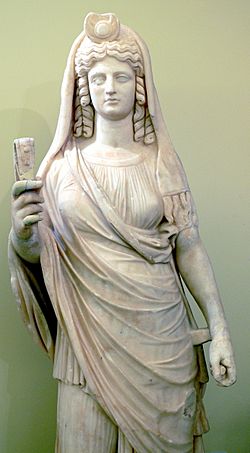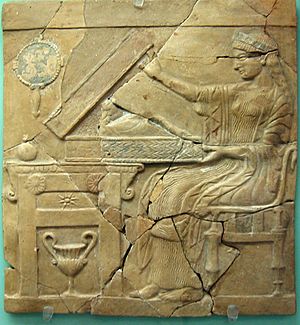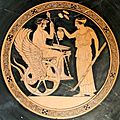Persephone facts for kids
Quick facts for kids Persephone |
|
|---|---|
| Queen of the Underworld Goddess of the dead, life, grain, spring, nature and destruction |
|

|
|
| Abode | The underworld, Sicily, Mount Olympus |
| Symbol | Pomegranate, seeds of grain, torch, flowers and deer |
| Personal information | |
| Spouse | Hades |
| Children | Melinoë, Zagreus/Dionysus (Orphic) Erinyes (Orphic) |
| Parents | Zeus and Demeter Zeus and Rhea (Orphic) |
| Siblings | Aeacus, Angelos, Aphrodite, Apollo, Ares, Arion, Artemis, Athena, Chrysothemis, Despoina, Dionysus, Eileithyia, Enyo, Eris, Ersa, Eubuleus, Hebe, Helen of Troy, Hephaestus, Heracles, Hermes, Iacchus, Minos, Pandia, Philomelus, Plutus, Perseus, Rhadamanthus, the Graces, the Horae, the Litae, the Muses, the Moirai |
| Roman equivalent | Proserpina |
| This article contains special characters. Without proper rendering support, you may see question marks, boxes, or other symbols. |
In ancient Greek mythology, Persephone (pronounced per-SEF-uh-nee) is a very important goddess. She is also known as Kore (pronounced KOR-ee), which means "the maiden." Persephone is the daughter of the powerful god Zeus and the harvest goddess Demeter.
Persephone became the queen of the Underworld after a dramatic event. Her uncle, Hades, who was the god of the underworld, took her away. One day, while Persephone was picking flowers in a field, Hades suddenly appeared. He burst through a crack in the earth in his chariot and snatched her. Persephone cried for help, but Hades carried her off to his dark kingdom.
Her mother, Demeter, searched everywhere for her daughter. She was heartbroken and very worried. When Demeter found out Hades had taken Persephone, she was furious. To show her sadness and anger, Demeter stopped all plants from growing on Earth. This caused a terrible famine, and people began to starve. Zeus, seeing the suffering, had to step in. He demanded that Hades let Persephone go.
However, Persephone had eaten some pomegranate seeds while in the Underworld. According to the rules of the gods, anyone who ate food from the Underworld could not leave permanently. So, Zeus made a deal: Persephone would spend part of the year in the Underworld with Hades. The rest of the year, she would return to the world above with her mother. This myth explains why we have seasons. When Persephone is in the Underworld, Demeter is sad, and winter comes. When Persephone returns, Demeter is happy, and spring arrives.
Contents
Who is Persephone?
Persephone is a goddess with many important roles. She is known as the Queen of the Underworld and a goddess of the dead. But she is also a goddess of life, spring, nature, and even destruction. Her story shows her connection to the cycle of life and death.
Goddess of Spring and Nature
Persephone is strongly linked to spring and the growth of plants. When she returns from the Underworld each year, it symbolizes new life. This is why she is often shown with a sheaf of grain or flowers. In ancient art, she usually wears long robes.
She was a main figure in the Eleusinian Mysteries. These were secret religious ceremonies that promised a happy afterlife to those who joined. The mysteries celebrated the idea of life returning after death, just like seeds sprout from the earth.
Some ancient thinkers believed Persephone was a goddess who created and destroyed everything in nature. They sometimes linked her to other powerful goddesses like Isis and Rhea. In some stories, Persephone is even said to be the mother of other gods, like Dionysus and Melinoë, with Zeus.
Queen of the Underworld
As the wife of Hades, Persephone rules the Underworld. She is sometimes called "dreaded Persephone" because of her power over the dead. In ancient times, people were sometimes afraid to even say her name when talking about the Underworld. This was because she was connected to a very old underworld goddess whose true name was kept secret.
In the famous epic poem Odyssey by Homer, the hero Odysseus meets Persephone in Tartarus (a part of the Underworld). She shares control over the dead with Hades. Groves of trees sacred to Persephone were believed to be at the very edge of the world, near the entrance to the Underworld.
Her story of going to and returning from the Underworld was central to the Eleusinian Mysteries. These secret rituals offered hope of a good afterlife to those who were initiated.
Persephone's Name

Persephone has had many different names throughout history. In ancient Greek, her name was Persephonē. Sometimes, she was called Persephoneia. Other names included Persephassa and Persephatta. The Romans called her Proserpina.
The meaning of the name 'Persephone' is not fully clear. Some ideas suggest it might mean "she who beats the ears of corn." This would connect her to harvesting grain. Another popular idea is that it means "to bring death," which fits her role as Queen of the Underworld. The many different forms of her name show how old and important she was to the ancient Greeks.
Images for kids
-
Sarcophagus with the abduction of Persephone. Walters Art Museum. Baltimore, Maryland
-
The Return of Persephone, by Frederic Leighton (1891)
-
From L-R, Artemis, Demeter, Veil of Despoina, Anytus, Tritoness from the throne of Despoina at Lycosura. National Archaeological Museum of Athens
-
A mosaic of the Kasta Tomb in Amphipolis depicting the abduction of Persephone by Pluto, 4th century BC
-
Pinax of Persephone and Hades from Locri. Reggio Calabria, National Museum of Magna Graecia.
-
Cinerary altar with tabula representing the abduction of Proserpina. White marble, Antonine Era, 2nd century Rome, Baths of Diocletian
See also
 In Spanish: Perséfone para niños
In Spanish: Perséfone para niños













